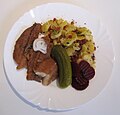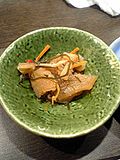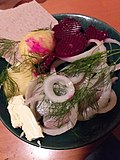| Name | Image | Origin | Description |
|---|
| Avruga caviar |  | Spain | Avruga is marketed by the Spanish company Pescaviar as a caviar substitute. It is made from herring (40%), salt, corn starch, lemon juice, citric acid, xanthan gum, sodium benzoate, squid ink and water. Unlike caviar, it does not contain fish roe. [17] |
| Bloater |  | England | Popular in the 19th and early 20th centuries, bloaters are now rare. They can be contrasted with kippers. Kippers are salted and cold-smoked overnight while bloaters are salted less and not smoked for so long. Kippers are split and gutted before smoking while bloaters are smoked whole without gutting. Kippers are associated with Scotland while bloaters are associated with England. Bloaters have their own characteristic slightly gamey flavor and are called "bloaters" because they swell or bloat during preparation. [18] [19] [20] [21] [22] |
| Brathering |  | Germany | A dish of fried marinated herring. A common recipe starts with fresh herrings with the head and gut removed that are breaded or turned in flour, fried and then pickled in a marinade of vinegar. The pickled herrings are then boiled briefly in water containing onion, salt, spices like pepper, bay leaves, mustard seeds, and a little sugar. The herring are served cold with bread and fried or jacket potatoes. [23] |
| Buckling |  | European | A hot-smoked herring similar to a kipper or bloater. The guts are removed but the roe or milt remain. Buckling is hot-smoked whole, as opposed to kippers which are split and gutted, and then cold smoked. Bucklings can be eaten hot or cold. [24] [25] |
| Dressed herring |  | Russia | A layered salad of diced salted herring covered with alternating layers of grated boiled vegetables (potato, carrot and beet root) and chopped onions. Optionally includes a layer of fresh grated apple. The final layer is beet root covered with mayonnaise, which gives the salad a rich purple color. Often decorated with grated boiled eggs. Popular in Russia and other countries of the former USSR, where it is traditional at New Year and Christmas celebrations. Also known as herring under a fur coat or just fur coat. [26] [27] [28] [29] |
| Eling |  | Suriname | Eling is smoked and salted herring (sometimes dried and salted), and is used in a variety of dishes in Suriname. [30] |
Fischbrötchen
(lit. fish sandwich) |  | Germany | A sandwich or roll made with fish and onions, sometimes also made with remoulade and pickles. Most commonly made with bismarck herring or soused herring, and eaten in Northern Germany, due to the region's proximity to the North Sea and Baltic Sea. |
| Gibbing | | Netherlands | |
| Gwamegi |  | Korea | |
| Herring noodle |  | Japan | Called Nishin-soba (にしん蕎麦) |
| Herring roe |  | Japan | Called Kazunoko (数の子). Usually, it is served as a part of Osechi in the Japanese new year. |
| Herring soup | | Sweden | |
| Herring spawn |  | Japan | Called Komochi-Kombu (子持昆布). Usually, it is served as a part of sushi or chinmi. |
| Herring spawn |  | Japan | Called matsumae-duke(松前漬け) |
| Herring with mushrooms | | Lithuania | Traditional Christmas Eve dish. Lithuanians have more than 100 different variations on how to prepare herring. |
| Kibinago |  | Japan | |
| Kipper |  | United Kingdom | A whole herring that has been split from tail to head, gutted, salted or pickled, and cold-smoked. |
| Pickled herring |  | Northern Europe | |
| Rollmops |  | Germany
Netherlands | Rollmops are pickled herring fillets, rolled into a cylindrical shape, often around a savoury filling. The filling usually consists of onion and sliced pickled gherkin. Rollmops are often skewered with a cocktail skewer. They are usually bought ready-to-eat, in jars or tubs. The brine additionally consists of water, white vinegar, and salt; it may also contain sugar or other sweetening agents, onion rings, peppercorns and mustard seeds. |
| Schmaltz herring | | Ashkenazi Jews (Eastern Europe) | |
| Śledzie |  | Poland | Pickled herring with chopped onions, eggs peeled and chopped (hard-cooked), apple - lemon juice, sour cream, garlic, salt and pepper, added to herring and mixed well, Sprinkled with dill or parsley. Served with rye bread. It is also traditionally one of the twelve dishes served at Christmas Eve (Wigilia). |
| Solomon Gundy |  | Jamaica | |
| Soused herring |  | Netherlands | 'Soused herring' is lightly brined raw herring, also known as "Hollandse nieuwe" in the Netherlands. It is often eaten with small cubes of raw onion. |
| Spekesild |  | Norway | A traditional Norwegian dish with salted and filleted herring, often along with boiled potatoes, raw onions, pickled beets, butter and flatbrød. Spekesild is also the basis for several variants that are placed on top of bread slices in boneless slices, such as pickled herring (sursild), spicy herring (kryddersild), mustard herring (sennepsild) and tomato herring (tomatsild). |
| Surströmming |  | Sweden | |
| Vorschmack |  | Ashkenazi Jews (Eastern Europe) | Chopped herring salad |



























